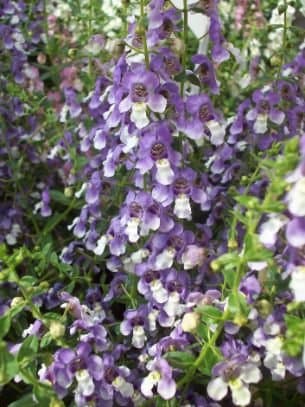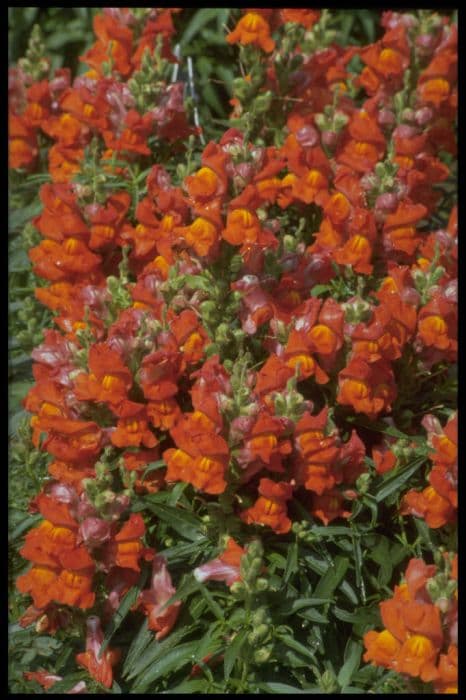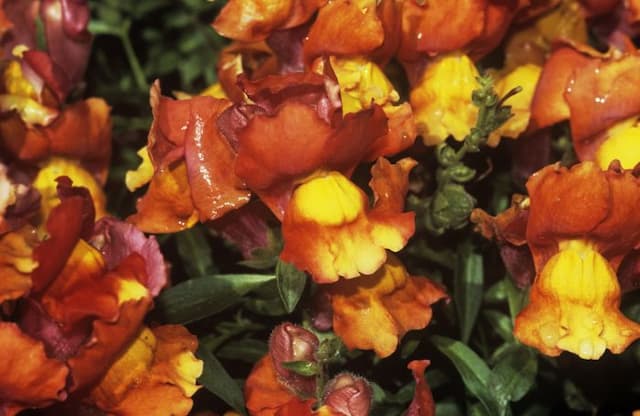Hebe Rhubarb and Custard Hebe Rhubarb and Custard = 'Tull 302' (PBR)

ABOUT
The Hebe Rhubarb and Custard is a visually striking plant known for its foliage that exhibits a vivid blend of colors. The young leaves emerge with a bold, mottled mix of red, yellow, and green hues which mature into a cream and green variegation. The creamy edges beautifully contrast with the green centers, creating an eye-catching pattern throughout the year. During cooler weather, the foliage can have a stronger red tone, adding to the appeal of the plant. Small flowers bloom in clusters, typically appearing in a purplish-pink shade that provides a soft, complementary burst of color against the variegated leaves. These blooms are particularly attractive to bees and other pollinators, adding an ecological benefit to its ornamental qualities. Overall, the intricate coloration of the Hebe Rhubarb and Custard's leaves makes it a standout choice for gardens and landscapes seeking a pop of color and textural interest.
About this plant
 Names
NamesFamily
Plantaginaceae
Synonyms
Rhubarb and Custard Hebe
Common names
Hebe 'Rhubarb and Custard', Hebe 'Tull 302'
 Toxicity
ToxicityTo humans
Hebe 'Rhubarb and Custard' is not widely recognized for being toxic to humans. However, in general, it is advisable not to eat ornamental plants due to the lack of information on their edibility and potential toxicity. If a person ingests a part of the Hebe 'Rhubarb and Custard', and symptoms of poisoning occur, they should seek medical attention. Symptoms of plant poisoning commonly include nausea, vomiting, diarrhea, and stomach pains. In some cases, more severe reactions could occur, but specific information on the toxicology of this cultivar is limited.
To pets
Hebe 'Rhubarb and Custard' is not commonly listed as a toxic plant to pets. However, as with humans, the lack of specific information on the toxicity of this particular cultivar means caution is advised. If a pet ingests part of the Hebe 'Rhubarb and Custard' plant, watch for signs of gastrointestinal distress, such as vomiting or diarrhea, or more severe symptoms like lethargy, changes in urine color, or difficulty breathing. If any of these symptoms are observed, it is important to contact a veterinarian promptly. It’s always best to prevent pets from ingesting garden plants when their toxicity is unknown.
 Characteristics
CharacteristicsLife cycle
Perennials
Foliage type
Evergreen
Color of leaves
Variegated
Height
3 feet (0.91 meters)
Spread
3 feet (0.91 meters)
Plant type
Shrub
Hardiness zones
7
Native area
New Zealand
Benefits
 General Benefits
General Benefits- Attractive Foliage: Hebe 'Rhubarb and Custard' has unique variegated leaves that are attractive throughout the year, adding color and visual interest to gardens.
- Low Maintenance: It requires minimal care once established, making it a good choice for gardeners who want a beautiful garden without a lot of work.
- Drought Tolerance: Once established, it is quite drought-tolerant, which is beneficial in areas experiencing water scarcity or for gardeners looking to conserve water.
- Compact Size: Its compact growth habit makes it ideal for small gardens, borders, and containers.
- Year-Round Interest: With evergreen foliage and flowers that bloom in early summer, this plant provides year-round interest.
- Pollinator-Friendly: The flowers attract bees and butterflies, supporting local ecosystems and pollinator populations.
- Versatility: It can be used in a variety of garden styles, including formal, cottage, and contemporary designs.
- Deer Resistance: Generally resistant to deer, which is particularly beneficial in areas where deer browsing can be a problem for gardeners.
- Coastal Suitability: The plant is suitable for coastal gardens as it can tolerate salty seaside conditions.
- Hardiness: It is winter hardy in many climates, making it a sturdy and reliable shrub for many environments.
 Medical Properties
Medical PropertiesThis plant is not used for medical purposes.
 Air-purifying Qualities
Air-purifying QualitiesThis plant is not specifically known for air purifying qualities.
 Other Uses
Other Uses- Creating a colorful hedge: The Hebe 'Rhubarb and Custard' can be planted in a row to form an attractive, informal hedge with its variegated foliage offering visual interest throughout the year.
- Container gardening: Due to its compact size, this Hebe variety is well-suited for container gardening, providing a burst of color on patios, balconies, or decking areas.
- Lining pathways: Planting Hebe 'Rhubarb and Custard' along garden paths can create a vivid border that helps define walkways and adds aesthetic appeal to garden design.
- Attracting wildlife: The flowers of Hebe 'Rhubarb and Custard' are attractive to bees and butterflies, making it an ideal plant for those looking to encourage biodiversity in their garden.
- Themed gardens: The plant's unique coloration makes it a suitable choice for fantasy-themed or whimsical gardens where unusual foliage is prized.
- Seaside gardening: Hebe 'Rhubarb and Custard' is salt-tolerant, making it a great addition to coastal gardens where other plants might struggle.
- Foliage contrast: This plant can be used in combination with plants that have dark green or purple foliage to provide a striking contrast and variety in the garden.
- Winter interest: Because Hebe 'Rhubarb and Custard' is an evergreen, it maintains its colorful foliage even in winter, providing year-round interest in temperate gardens.
- Topiary: For the creative gardener, the dense foliage of Hebe 'Rhubarb and Custard' can be trained and trimmed into topiary forms, adding structure and artistry to a garden space.
- Rock gardens: Given its compact growth habit and colorful leaves, Hebe 'Rhubarb and Custard' is also an excellent addition to rock gardens, contributing to the variety of textures and colors.
Interesting Facts
 Feng Shui
Feng ShuiThe plant Hebe is not used in Feng Shui practice.
 Zodiac Sign Compitability
Zodiac Sign CompitabilityThe plant Hebe is not used in astrology practice.
 Plant Symbolism
Plant Symbolism- Youth: The genus Hebe was named after the Greek goddess of youth, and it is often associated with maintaining youthful vigor.
- Unity: The diverse colors of the 'Rhubarb and Custard' variety, merging the deep tones with lighter ones, symbolize the coming together of different elements in harmony.
- Exuberance: The vibrant foliage of 'Rhubarb and Custard' exemplifies a joyful energy and the exuberance of life.
- Diversity: The unique color combination represents diversity and the celebration of differences.
 Water
WaterThe Hebe 'Rhubarb and Custard' should be watered regularly to keep the soil consistently moist but not waterlogged. During the growing season, it typically requires watering once every week or more frequently during periods of drought or extreme heat. It's important to provide deep watering that reaches the root system, approximately 1 gallon per watering session. In winter, reduce watering to every two weeks or less, depending on the climate, as the plant's water needs decrease in cooler temperatures.
 Light
LightThe Hebe 'Rhubarb and Custard' thrives best in full sun to partial shade. It prefers a spot that gets at least 6 hours of direct sunlight each day, but can also tolerate some light shade, especially in hotter climates. Ensure it's planted in a well-lit area where it can benefit from bright, indirect light for the healthiest growth.
 Temperature
TemperatureThe Hebe 'Rhubarb and Custard' prefers a temperate climate and does well with temperatures ranging between 30 to 75 degrees Fahrenheit. It can survive brief periods of colder temperatures down to about 20 degrees Fahrenheit, but prolonged exposure to extreme cold or frost can damage the plant. The ideal temperature range is between 50 to 70 degrees Fahrenheit for optimal growth.
 Pruning
PruningPrune the Hebe 'Rhubarb and Custard' in early spring to maintain its shape and encourage bushier growth. It should be pruned lightly after the blooming period to remove spent flowers and any dead or damaged branches. Pruning can be performed annually and is also beneficial to revitalize older plants and prompt fresh growth.
 Cleaning
CleaningAs needed
 Soil
SoilHebe 'Rhubarb and Custard' prefers well-draining soil enriched with organic matter, with a pH range of 5.5 to 6.5. A suitable soil mix can be prepared by blending one part garden soil, one part peat or coco coir, and one part perlite or sand to improve drainage.
 Repotting
RepottingHebe 'Rhubarb and Custard' generally does not require frequent repotting and can be repotted every 2 to 3 years, or when the plant outgrows its current container.
 Humidity & Misting
Humidity & MistingHebe 'Rhubarb and Custard' tolerates a wide range of humidity levels and can thrive in the typical humidity found in outdoor garden environments, without the need for specific humidity adjustments.
 Suitable locations
Suitable locationsIndoor
Position near a sunny window and ensure good ventilation.
Outdoor
Plant in well-draining soil, full sun to partial shade.
Hardiness zone
7-10 USDA
 Life cycle
Life cycleHebe 'Rhubarb and Custard' begins its life cycle when seeds are sown or vegetative cuttings are rooted, typically in a controlled environment for propagation. The germinated seedlings or rooted cuttings are then transferred to pots or garden beds where they undergo a juvenile phase, developing a strong root system and foliage. As the plant matures, it enters the vegetative growth stage, forming a bushy evergreen structure with variegated leaves that are green and cream with pink edges. Flowering occurs in summer, presenting spikes of purplish-pink flowers that attract pollinators. After pollination and flowering, if conditions allow, the plant may produce seeds, although Hebe 'Rhubarb and Custard' is often propagated vegetatively. Finally, as the plant ages, it may become woody and less vigorous, and without proper maintenance, it can decline and eventually die, completing its life cycle.
 Propogation
PropogationPropogation time
Spring to Summer
The Hebe 'Rhubarb and Custard' can be propagated through semi-hardwood cuttings, which is the most popular method for this plant. The best time to take cuttings is in late summer. Cuttings should be about 4-6 inches (10-15 cm) long and have several leaves. The lower leaves are removed, and the cut end of the cutting can be dipped in rooting hormone to encourage root development. The cutting should then be placed in a well-draining potting mix and kept moist but not waterlogged. Maintaining a high humidity level around the cutting by covering it with a plastic bag or placing it in a propagator can be beneficial. Roots typically develop within 4-8 weeks, after which the new plants can be gradually acclimatized to normal conditions.









